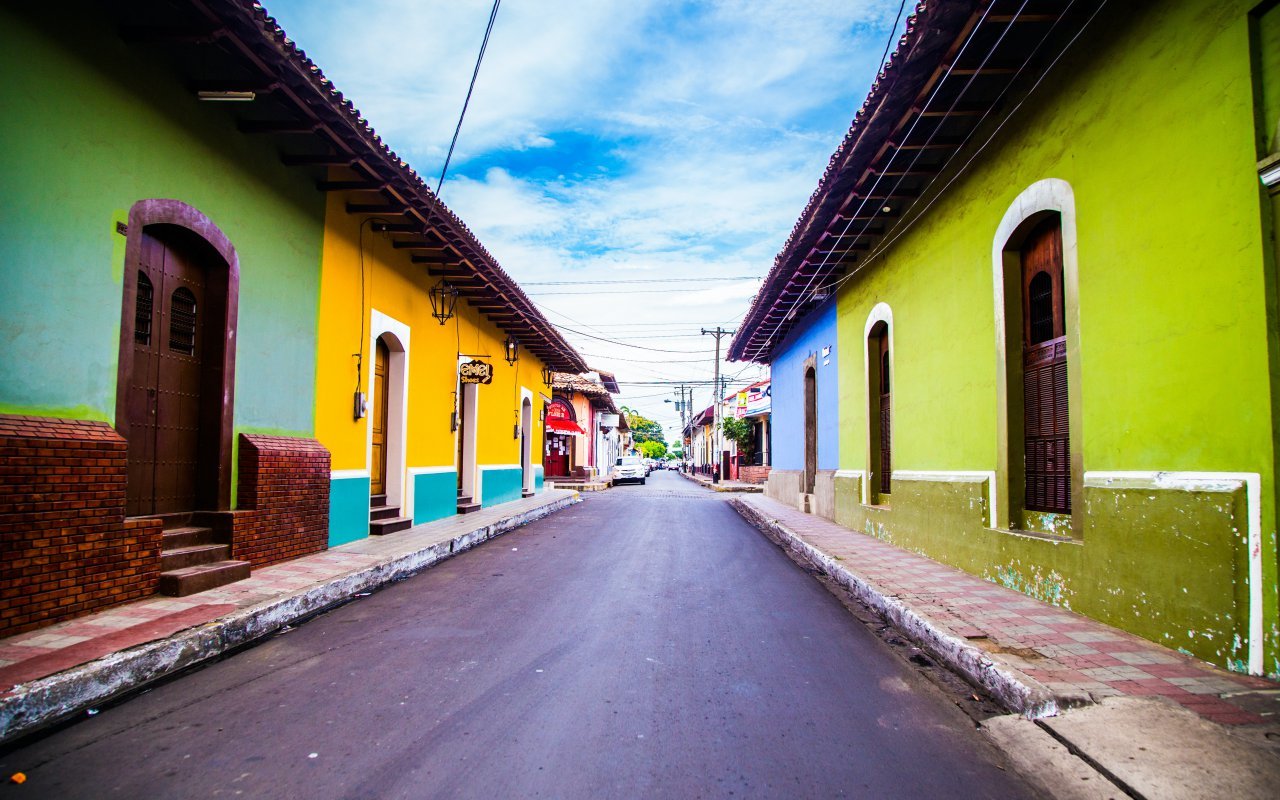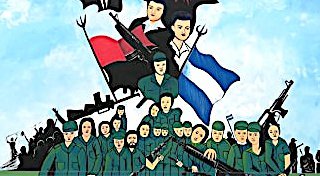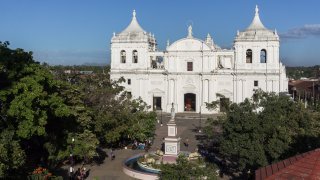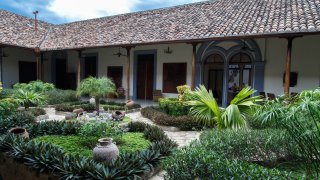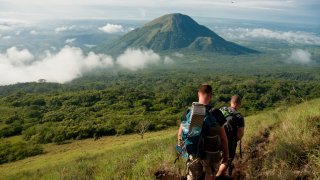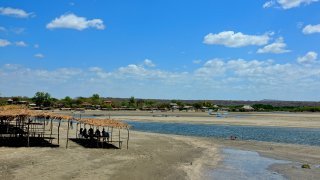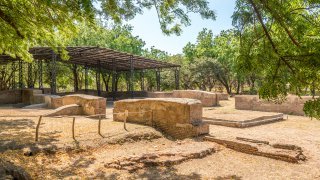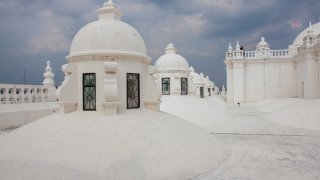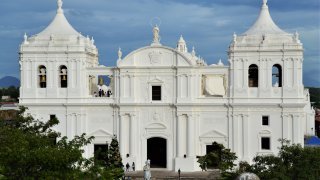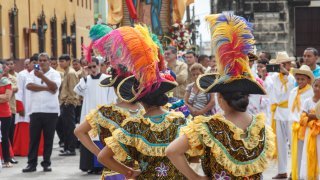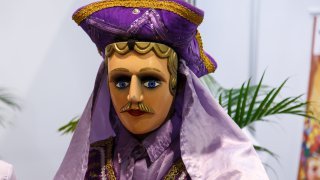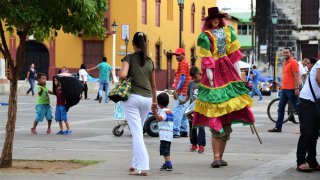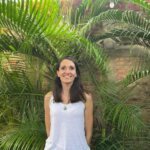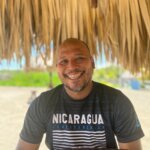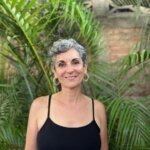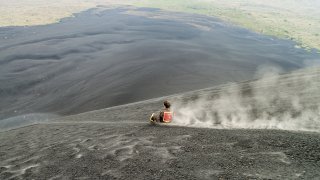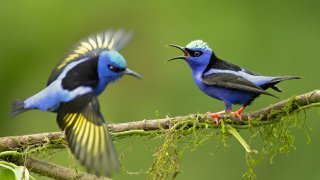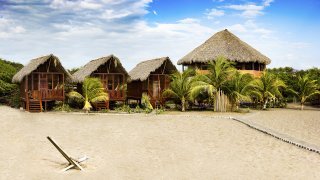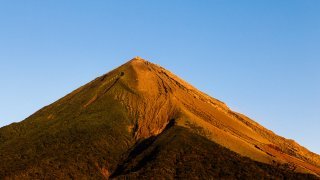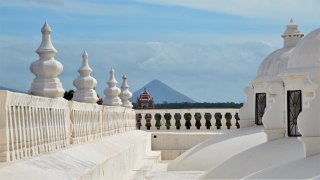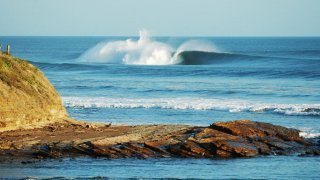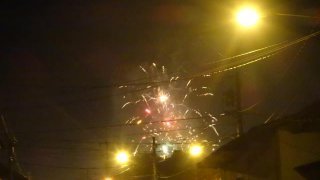Santiago de los Caballeros de León
León or Santiago de los Caballeros de León is like a capital. This colonial-style city is warm because of its climate, its history and the close proximity to its people. You quickly feel at home here.
This famous capital of the Sandinista revolution is today a large student and popular city, quite the opposite of the very chic and conservative Granada. You can still feel the history and the powder in the walls and facades of the city. It’s almost a pilgrimage for some Sandinistas or melancholic people of the red central American cause.
But it is also a religious city! There are more than a dozen churches, baroque to neoclassical. You can feel the history and the “colombisation” of the continent. It is impossible to miss the legendary great white cathedral, a symbol of the city. The Cathedral of La Asunción dates back to the 18th century. Guarded by giant lions carved on its porch, its entrance is always free and the visit always fresh.
As a lover of arts and culture, León has several museums, including the famous Ortiz Guardian, a museum of contemporary art located in two beautiful colonial buildings. Ruben Dario, the national writer and poet of the late 19th century, also has a museum dedicated to León, the national capital of poetry on certain occasions. Born in the city, his childhood home contains many objects and archives of the artist.
History
The well-known and renowned conquistador Hernandez de Cordóba founded “his” first city in Nicaragua in 1524 on the site of the current ruins of León Viejo, in front of the Momotombo volcano. The city was relocated, following an earthquake and the eruption of the volcano that dominated the city, further north and next to the village of Sutiaba, today still an indigenous outlying neighborhood of the capital of the revolution.
León became the capital of Nicaragua’s stewardship with the Spaniards and also became the capital of the state of Nicaragua. It remained so temporarily until the beginning of the 19th century.
At the independence of Nicaragua, León became the capital of the country. In 1839, León and Granada shared the status alternately, and the historical rivalry was born between the two cities, between liberals and conservatives. The city of Managua, located between the two parties, was chosen in 1858 to put an end to this quarrel.
León lives and remains under the threat of several volcanoes. Several times, ash rains have fallen on the city, these came from the Cerro Negro which exploded at least three times in this second half of the 20th century (1968, 1971 and 1992). At that time, the inhabitants were in the habit of evacuating.
The city continued to live and even became a real bastion during the Sandinista revolution. In September 1978, Nicaragua rose up against Somoza, the dictator. A Student Revolutionary Front (FER) was created in Leon, the country’s major university city. The Somozist National Guard managed to keep control and many rebels took refuge in the countryside around Leon. Some students remained in the field, did not leave the battle, or unfortunately not in time, and a massacre of “insurgent children” took place. The planes were circling over León, and so was the army. The insurrection will eventually resume and the Sandinista front will experience a real victory in León in July 1979, the beginning of the end of the reign for the Somoza family in Nicaragua.
What to do in and around León?
The city and region of León offers many possibilities. We advise you to have a walk around the city so that you can take the time to discover its many neighborhoods, markets, churches, streets, atmosphere, museums,…
Central Park Visit
Take time to sit on a bench in the central park to observe the surrounding buildings such as the cathedral, the city hall, the bishop’s palace or the Seminario Tridentino San Ramón college.
Churches
There are more than 17 churches in the city, here are a few of them:
- The Cathedral of León or Basílica Catedral de la Asunción (read below)
- The Merced Church
- The Recolección Church
- El Calvario Church
- San Francisco Church
Museums
- Museo Rubén Darío, located in the house where this Nicaraguan poet lived for 14 years, the museum has several personal objects of this artist that retrace his life and history.
- Museo de Arte Fundación Ortiz-Guardián, this art museum exhibits contemporary paintings, sculptures, imagery and crafts in two beautifully restored colonial buildings.
- Museo de Tradiciones y Leyendas, located in a building that served as a prison during the Somoza family’s regime in the 1920s, this museum is dedicated to 14 Nicaraguan myths and legends.
- Mausoleo de Héroes y Mártires, Museum of the Revolution: in front of the cathedral on the central park, this museum in an old house of the city retraces the events of the revolutions of the 70s.
- The ruins of León Viejo, open-air archaeological museum of the first city of León (read below).
Volcanoes around Leon
Around Leon, you can go on various hikes and treks on the volcanoes of the Maribios chain:
- Cerro Negro Volcano
- El Hoyo Volcano
- Telica Volcano
- Momotombo Volcano
- San Cristóbal Volcano
- Cosigüina Volcano
Beaches and nature reserves
Finally, to get out of the heat of the city and cool down by the Pacific Ocean, several beaches are possible:
- Playa Las Penitas and the Isla Juan Venado Nature Reserve.
- Playa Poneloya
- Playa Salinas Large
- Playa Miramar
- Playa El Transito
UNESCO Listed Sites
The ruins of León Viejo
León Viejo is the second oldest city in Nicaragua, at least what remains of it: ruins. Founded in 1524, it was then one of the most important and prosperous cities of the region, a colony, a trading post. A lot of wealth collected and plundered in the surroundings passed through its center and its market.
The city was built near the lake of Managua and not far from the Momotombo volcano. This one exploded half a century after the foundation of the city.León was not destroyed by the volcano but rather invaded and covered with ashes and volcanic stones. It was nevertheless a disaster. 30km to the west, a new “León” was built, the city of León we know today.
The ruins of León Viejo were recognized as a UNESCO World Heritage Site in 2000.
Stroll quietly through the remains of the city, climb the small hill on the site of an old fort and contemplate the splendid view of the lake and the volcanoes that surround the place.
The Cathedral of León
The Basílica Catedral de la Asunción de León, located in the central square, was erected in several stages between 1746 and 1860, renovated in 1992 and repainted in white in parts since 2015.
This five-nave construction is divided into seven basement compartments, three of which are open to the public and each one offers a different history. They were used as tombs for the richest, storage places for pirate treasures or tunnels to escape in case of attack. The most spectacular tomb is that of Rubén Darío, the famous poet of Nicaragua, whose tomb is protected by a lion in the center of the cathedral.
Inside, beyond the freshness of the building, you will appreciate the richness of the architecture and decoration.
It is possible to visit the roof of the cathedral. At the top, you will walk barefoot between the 34 domes, numerous church bells and four statues and you will be able to admire the beautiful view of the city of León, its streets, churches and also the volcanoes around the Maribios mountain range.
The Basílica Catedral de la Asunción de León was declared a World Heritage Site by UNESCO in 2011.
The traditional festivities of León
Throughout the year different festivals are celebrated in León. Here are the main dates:
January
- from the 15th to the 21st: international festival of the Poetry of Rúben Dario
- 3rd weekend : Viva León Festival
Late March / early April
- Holy Week during which many processions take place. The streets of the Sutiaba neighborhood are decorated with colorful and ephemeral paintings based on ashes and sawdust.
August
- the 14th: the Gritería Chiquita. Celebration in homage to the Virgin Mary, who would have answered the call of Bishop Isidro Augusto Oviedo y Reyes and stopped an ash cloud that surrounded and suffocated the city of León following a volcanic eruption of the Cerro Negro.
September
- the 24th: celebration of the Virgen de la Merced or Nuestra Señora de las Mercedes, Patroness of the city of León.
- on the 29th and 30th: San Jerónimo. Processions between the church of Sutiaba and the cathedral in honor of San Jerónimo with folk dances to the sound of drum beats.
December
- all month: The “Gigantones”. They are representations of characters from the colonization period: The Gigantona named Florentina is a giant doll dressed in a colorful dress and jewelry. She represents a Spanish lady accompanied by El Enano cabezón, a dwarf with a big head, who recites verses that satirize and criticize the social events of the city and the country.
- On the 07 and 08: La Purisima or the Gritería. This is the most important religious festival in León, celebrated in honor of the Conception of the Virgin Mary. In addition to the fireworks and music, the people of the city erect altars in the windows and give sweets or gifts to the passers-by who sing and shout fervently “Que causa tanta alegría? “before answering “! La Concepción de María! ».
